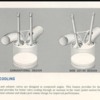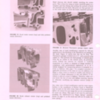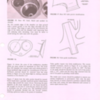Interesting. It's going to idle around 850 and have about 14 inches of vacuum.
For a street car it is close to a MAX cam. I'm running three CompCams in three different engines.
The one in my Pantera is the solid lifter, .606 lift and 244° @ .050. It is border line liveable on the street. If it was an everyday car, it would be too hot,
Your 230° intake duration is going to make yours rather civil.
Here's the thing though. With that lift you are going to need more than "average/normal" maintenance. Mostly you should change out the valve springs periodically for safety. They aren't going to be 30,000 mile items.
You may experience push rod and rocker arm related failures as well?
It is going to have VERY decent off idle torque and power, a HUGE mid range and scream in the upper rpm's. Likely this is what the "tech" told you and if so, he's right.
I can vouch for the CompCams tech information. It is largely accurate.
180's in a Pantera are "tuned" for 6,700 to 6,800 rpms'. You can change that a little by playing with step tube design of the primaries or enlarging or decreasing the ID of the pipes but not drastically. The engine will turn way more then that but you may experience a flat spot right there or seem like you are suddenly pushing a stack of bricks up a hill so really the lift of that cam is PROBABLY unnecessary? With Cleveland heads right around .588" actual lift is where they seem to max out.
A .624 lift is getting up there with the 8,000 rpm engines and with hydraulic lifters, that is somewhat of a contradiction since those are likely somewhere around a 7,200 rpm float. At least that's where mine did?
Cams being what they are you need to run them in YOUR application to see if they are filling the requirements. In that sense, the results are unpredictable since YOUR interpretation MAY vary from the theoretical predictions.
One additional comment here. George's cam profiles are similar to the stock CJ cam with more lift. A 113° center line cam is something generally you would do with an exhaust that has issues. The PORT itself, not necessarily the back pressure of the exhaust system AFTER the port.
An example of that would be the Ford FE series. It has a lousy exhaust port design regardless what FE series it is (all the exhaust ports are the same) which generally speaking you can't fix. As a result it doesn't respond well to 110° center lines and most builders recommend a 113 in that case.
The stock iron Cleveland head has a lousy exhaust port also. It was so bad that for Pro-stock racing it was radically sectioned and a 1" aluminum bar was added that corrected the port flow to almost straight up. Now I don't know the cam profiles that someone like Nicholson was using but it might have been even more radical then a 106°? Maybe a 104 with a ridiculous lift around .800?
The 110° in your cam won't hurt anything in the engine but the engine just won't be able to take full advantage of it. So with iron heads you CAN do what George did and go to a 113 and calm the engine down without loosing any power.
IF you were using something like one of the Ford aluminum "high port" heads the exhaust port configuration in them can take advantage of the 110. That just means that you will be able to get more horsepower out of the exhaust side of the engine. Maybe another 35 to 50 hp?
To say that aftermarket cam grinders don't know what to do with a Ford "Cleveland" style valve configuration is just not true. Chevy brought out the "mystery engine" in '63 and it's cylinder head was the basis for the "Big Block" Chevy head. They have similar port configurations, BUT an aftermarket cam profile with 110 centers is for an Ford Cleveland head that has had it's exhaust PORTS "corrected".
The issue with the Ford Cleveland iron production head is the bad exhaust ports.




